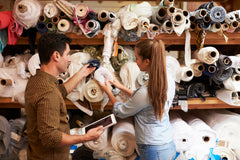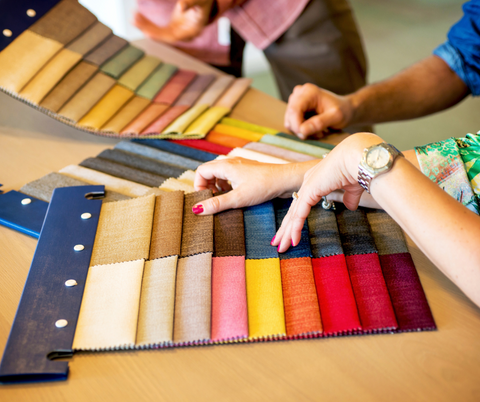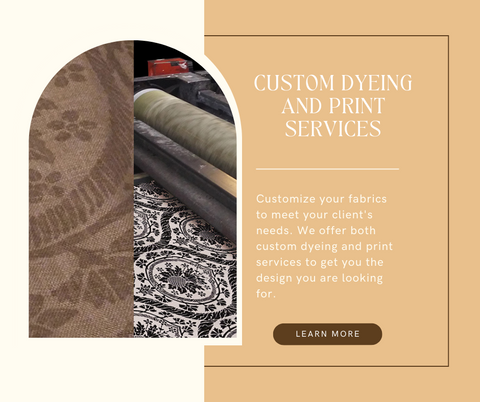The world of textiles is as vast and varied as a designer’s creative imagination. Yet the sheer diversity of upholstery fabric available can be both a thrill and bewildering.
It can feel like a journey just to choose the right upholstery fabric, not to mention where to buy upholstery for your project. In fact, where you purchase textiles plays a pivotal role in the success of your design, influencing everything from quality and cost to availability and sustainability.
Whether you’re an experienced designer searching for fresh sources or a newcomer eager to explore the world of textiles, let’s unravel the mysteries behind where to find the perfect fabrics that align with your design vision.
3 Options: Where To Buy Upholstery Fabric
You typically have three options when it comes to where you purchase your

upholstery fabric:
- Manufacturer/wholesale supplier
- Distributor
- Retailer
A manufacturer or wholesale supplier produces upholstery fabrics in bulk and sells them to distributors or retailers, offering a wide range of fabric options to businesses. This can be a great option for designers to pick up upholstery fabric at a lower cost, but manufacturers and wholesale suppliers may have minimum order requirements. If your project doesn’t involve using a bulk amount of fabric, this option may not be available to you.
A distributor is an intermediary that acquires upholstery fabrics from manufacturers or wholesale suppliers and then sells them to retailers or other businesses, helping ensure efficient supply chain management. The downside to purchasing from a distributor is that the intermediary often marks up the wholesale price before selling it to you.
Finally, a retailer is a business that sells upholstery fabrics directly to consumers or end-users. A retailer can be a national chain store, online store or a mom-and-pop shop. Retailers often have the highest prices and lowest quantities, though can be a quick option if you need fabric quickly.
Another type of retailer is an outlet, which can be found online or at a brick and mortar location. These fabrics are set at clearance prices since many of the designs are discontinued. Upholstery fabric may also end up at a fabric outlet if a manufacturer or fabric store has excess quantities that didn’t sell, and the company needs to make room for new fabrics coming into stock. Outlets can offer great prices, but extremely limited quantities.
Important Factors To Consider
When designers are faced with the important decision of where to source their upholstery fabrics, they must weigh various factors to determine whether a manufacturer, distributor or retailer best aligns with their specific project needs and design goals. Here are key considerations for each option:
Manufacturer/Wholesale Supplier:
- Fabric Customization: Manufacturers often offer the possibility of customizing fabrics to meet your unique design requirements. Consider this option if you have specific color, pattern or material preferences that are central to your project. (We’ll talk more about customization options below.)
- Bulk Ordering: If your project requires a substantial quantity of a particular fabric, working directly with a manufacturer or wholesale supplier can be cost-effective, as they typically offer discounts for bulk purchases. However, if you can’t meet minimum order requirements, a manufacturer or wholesale supplier may not be the best choice for your project.
- Lead Times: Be mindful of production lead times. Manufacturers may require more time to produce custom or large orders, so plan your project timeline accordingly.
- Quality Control: Manufacturers maintain greater control over the fabric's quality, ensuring that it meets industry standards and your expectations. This can be particularly important for high-end or specialized projects.
Distributor:
- Variety and Selection: Distributors often have a wide range of fabrics sourced from multiple manufacturers. This can be beneficial if you're looking for diverse options within your design concept.
- Convenience: Choosing a distributor can simplify the sourcing process, as they act as intermediaries between manufacturers and retailers. This can save you time and effort in procurement.
- Logistics and Shipping: Distributors are experienced in handling the logistics of shipping and delivery. If you have concerns about the seamless transport of materials to your project site, a distributor can be a valuable partner.
- Cost Considerations: Distributors may offer competitive pricing, but it's essential to compare costs with those of manufacturers and retailers to ensure you're getting the best value for your budget. As we mentioned above, distributors will mark up manufacturer prices before selling to the end-user.
Retailer:
- Small-Scale Projects: Retailers are a good choice for smaller projects or when you need a limited amount of a specific fabric, as they typically sell fabrics in manageable quantities.
- Immediate Availability: Retailers often have fabrics readily available for immediate purchase, making them suitable for projects with tight deadlines.
- Lower quality: Retailers often sell fabrics that are of lower quality so they can keep costs down. If an upholstery project includes pieces that need to wear well, a retailer is likely not the best option.
Ultimately, the decision between a manufacturer, distributor or retailer should align with the unique requirements of your design project. Consider the project scale, customization needs, budget constraints, timeline and the level of control you wish to maintain over fabric quality when making your choice.
An Opportunity To Customize
When weighing your options, one important advantage of working with upholstery wholesale fabric suppliers or manufacturers is the opportunity to customize your perfect fabric. Customizations allow you to fulfill the unique requirements of your project and client, and go beyond simply the look of the fabric. Here are some of the different ways you can create a truly unique piece.
Colors
Color is a remarkable avenue for customization, allowing individuals to infuse their unique tastes and personality into their design choices. With a vast array of hues available, clients have the opportunity to select colors that resonate with their preferences in style.

Whether it’s the soothing embrace of serene blues, the vibrant energy of fiery reds or the timeless elegance of neutral tones, color serves as a canvas for personal expression, breathing life into spaces and reflecting the distinctive character of those who inhabit them.
As a designer, it’s important that you do not rely on the manufacturer’s website for color, however. It is better to request a color swatch or sample so that you are more likely to receive the color you desire. Dye lot variations are common in the textile industry, and color shifts can happen with “stock” colors.
Having your own custom dye lot created can help ensure your upholstery fabric is the color you want since much more stringent controls are added so that the mill can meet the specifications. The result is repeatable and reliable with a maximum variation of 3% to 5%.
Printing
For those seeking a truly distinctive design, custom printing offers an excellent path toward creating an exclusive look. This versatile technique can take any piece of upholstery and turn it into a showpiece. Custom printing can be used on a variety of upholstered pieces, from accent chairs to window draperies, couches or sofas, ottomans, wall paper, outdoor fabric pieces or other home decor items.
There are two types of printing services available: Rotary/flat bed printing and digital printing.
Rotary/flat bed printing is a direct-to-fabric printing technique where the image is engraved on precision cut stencils, also known as screens. Multiple screens can be used to create a multi-color design and can produce vivid colors and intricate designs on your upholstery fabric. Crisp lines and detailed images are created using screen printing, allowing inks to penetrate the fabric and hold color better and longer.
Digital printing on fabric is also known as DTG, or direct-to-garment printing. Digital printing is any ink-jet based method of printing colorants onto fabric. This process allows for lower minimums, eliminates screen charges and removes the need for screen storage.
Backing
Manufacturers often add backing to upholstery fabric to help prevent seams from slipping and to add durability.
Latex backing is commonly used on furniture upholstery since the coating helps prevent soil from sifting through the fabric. Knit backing can also make lighter weight fabrics more durable, allowing designers to use fabrics like chenille and silks for upholstered pieces.
Backings that darken rooms are also popular today both in residential and commercial properties. For example, in hotels, backings can block most or all of the light that enters through a window, ensuring quality sleep. Some curtains that feature blackout backing also have noise-dampening properties, and in homes, blackout curtains can help regulate indoor temperatures.
Protective Coatings
Protective coatings can lengthen the lifespan of an upholstered piece by protecting it against everyday dirt and grime.
A popular protective finish used in homes and offices for furniture upholstery fabric is called a nano coating, a very thin transparent plastic polymer film coating that helps to repel dry particles, water, oil and dirt. Other options include Scotchgard and Alta treatments, which protect the fabric against dirt and spills.
Manufacturers can also apply antimicrobial, antibacterial and antifungal treatments to prevent the buildup of bacteria, fungi and dust mites. These treatments are typically needed for design projects at schools, hospitals and outdoor environments.
Fire Coatings
If you are designing for a commercial project, protective coatings are often required in order to protect the public. In the state of California, furniture must comply with TB117-2013. This fire rating regulation requires that upholstery fabric pass smolder cigarette tests.
Fabrics used in public places must also meet fire safety standards as outlined by the National Fire Protection Association. Fire retardant applications are also required under California law for public spaces. Fire retardant applications can be sprayed on or brushed on and help limit the spread of a fire. Rather than igniting, the fabric is protected under intense heat.
Which Upholstery Fabric Source Is Best?
The answer to that question depends on several factors, including quantity requirements, customization opportunities, budget, your project timeline and the variety of upholstery fabric you wish to be available to you.
Collaborating with a wholesale supplier can help guarantee access to the upholstery fabric quantities you require, and may be a better option for your budget and desire to create a unique look. This partnership opens doors to customization options that can elevate your project to new heights. However, it’s crucial to verify whether your chosen supplier imposes minimum order requirements before you order to kickstart your project on the right note.






